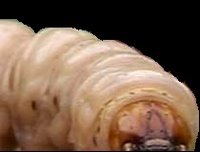Maggot (larva) therapy
For centuries, it has been known that wounded soldiers whose injuries had been infested with maggots often had a lower mortality rate and actually healed more quickly than similarly wounded individuals without maggots. While this may seem disgusting in the extreme, maggot therapy is still a viable treatment for some illnesses or injuries, the most common of which are gangrene, diabetic ulcers, bed sores and some post surgical wounds.
 Maggots -- the larval stage of flies -- are helpful in three ways. First of all, they debride (clean) the wound by dissolving the necrotic (dead) tissue. In fact, they are often more effective at cleaning infected and/or gangrenous wounds than many commonly prescribed treatments. Secondly, they eat harmful bacteria, which serves to actually disinfect the wound. And third, they stimulate healing.
Maggots -- the larval stage of flies -- are helpful in three ways. First of all, they debride (clean) the wound by dissolving the necrotic (dead) tissue. In fact, they are often more effective at cleaning infected and/or gangrenous wounds than many commonly prescribed treatments. Secondly, they eat harmful bacteria, which serves to actually disinfect the wound. And third, they stimulate healing.
Needless to say, physicians use only disinfected medical grade maggots bred specifically for therapeutic applications. And research is currently underway to isolate and manufacture beneficial maggot-derived factors so that one day physicians can dispense with the actual maggots.
Reference: University of California at Irvine Health Sciences
 Maggots -- the larval stage of flies -- are helpful in three ways. First of all, they debride (clean) the wound by dissolving the necrotic (dead) tissue. In fact, they are often more effective at cleaning infected and/or gangrenous wounds than many commonly prescribed treatments. Secondly, they eat harmful bacteria, which serves to actually disinfect the wound. And third, they stimulate healing.
Maggots -- the larval stage of flies -- are helpful in three ways. First of all, they debride (clean) the wound by dissolving the necrotic (dead) tissue. In fact, they are often more effective at cleaning infected and/or gangrenous wounds than many commonly prescribed treatments. Secondly, they eat harmful bacteria, which serves to actually disinfect the wound. And third, they stimulate healing.Needless to say, physicians use only disinfected medical grade maggots bred specifically for therapeutic applications. And research is currently underway to isolate and manufacture beneficial maggot-derived factors so that one day physicians can dispense with the actual maggots.
Reference: University of California at Irvine Health Sciences


0 Comments:
Post a Comment
<< Home